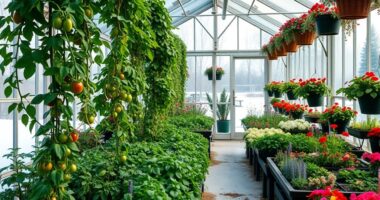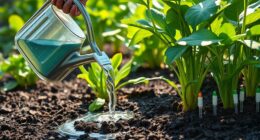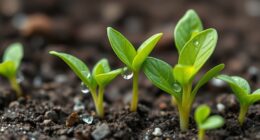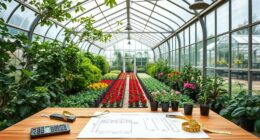For your greenhouse this spring, leafy greens like lettuce and spinach thrive in cooler temperatures, making them perfect early crops. Warm-season vegetables such as tomatoes and peppers can be started indoors, while root vegetables like radishes and carrots mature quickly. Don't forget about fruiting plants like strawberries and herbs like basil to enhance your garden. With the right techniques, you'll maximize your growth potential. Keep exploring to unlock more tips and tricks for a flourishing greenhouse!
Key Takeaways
- Leafy greens like lettuce and spinach thrive in cooler temperatures and can be harvested early in spring.
- Warm-season vegetables such as tomatoes and peppers should be started indoors by early March for optimal growth.
- Quick-growing root vegetables, including radishes and beets, are perfect for spring planting with fast maturation times.
- Fruiting plants like strawberries and citrus fruits benefit from greenhouse conditions, offering early yields and pest resistance.
- Herbs such as basil and parsley enhance culinary dishes and can be grown easily in a greenhouse setting.
Leafy Greens: The Perfect Spring Options

When you think of spring crops for your greenhouse, leafy greens should top your list. Their quick growth ensures you can enjoy an early harvest, especially when planted a month ahead of outdoor crops. Varieties like lettuce, spinach, and kale thrive in cooler temperatures, making them ideal for spring. You'll appreciate how easy they're to grow; with proper care, leafy greens like arugula and Swiss chard provide continuous yields throughout the season. Plus, your greenhouse protects them from pests, allowing for healthier plants and enhanced flavors. With a mix of cold-hardy options, you can create a diverse and productive spring garden, ensuring a fresh supply of greens for your table. Succession planting of cilantro every two weeks ensures a continuous supply of fresh herbs to complement your leafy greens.
Warm-Season Vegetables to Start Early

As you wrap up your leafy greens harvest, you might be eager to look ahead to the warm-season vegetables that can thrive in your greenhouse.
Starting tomatoes, peppers, and eggplant indoors in late February to early March gives you a jump on the season, as they take about six to eight weeks to mature. For a quicker turnaround, consider okra and basil, which can be started indoors in late April and are ready to transplant in just three weeks. Frost-tolerant crops can also be started early in your greenhouse to ensure a fresh harvest before the summer heat sets in.
Ensure your greenhouse maintains temperatures above 65°F, provides full sunlight, and has well-drained, nutrient-rich soil.
Regularly monitor moisture levels to avoid root rot, and remember to harden off seedlings before moving them outside for the best results.
Root Vegetables for a Spring Harvest

If you're looking to maximize your greenhouse's potential this spring, root vegetables are an excellent choice.
Start with radishes, which germinate quickly, maturing in just 28 to 45 days. Beets thrive in cool weather and full sun, ready for harvest in 55 to 70 days.
Radishes mature in 28 to 45 days, while beets flourish in cool weather, ready in 55 to 70 days.
Carrots prefer loose, well-drained soil and take about 60 to 80 days to grow. For a longer season, consider parsnips, needing 100 to 120 days. Root vegetables serve as nutrient storage for plants, rich in vitamins and minerals, making them a healthful addition to your spring garden.
Turnips can be sown early in spring or late summer for a fall crop. Prepare your soil well, ensuring it's loose and nutrient-rich.
With proper care, you'll enjoy a bountiful harvest of delicious root vegetables, perfect for your spring meals!
Fruiting Plants to Grow in Your Greenhouse

While greenhouses provide an ideal environment for growing a variety of plants, fruiting plants particularly thrive under these controlled conditions.
You can start with strawberries, which flourish early and resist pests. Greenhouses create ideal conditions for strawberries, encouraging early fruiting.
Citrus fruits like lemons and limes need stable temperatures and are perfect for larger setups.
If you prefer low-maintenance options, figs work well in containers.
Melons extend your growing season even in cooler climates, while grapes can be trained vertically, maximizing space.
For a tropical touch, consider pineapples, kiwis, or passion fruit, all loving warmth and humidity.
Don't forget about guavas and papayas, which also do well in greenhouses.
Thriving Herbs for Spring Gardening

When you dive into spring gardening, choosing the right herbs can elevate both your culinary creations and your greenhouse experience.
Start with basil, which loves warmth and at least six hours of sunlight—perfect for Italian dishes. Basil requires regular watering to thrive in your garden.
Chives are low-maintenance perennials that thrive in containers, needing just 4-6 hours of sun.
Don't forget coriander; it adds a unique flavor to Asian and Mexican cuisine and prefers well-drained soil with partial sunlight.
Mint, while invasive, brings refreshing taste and should be contained.
Lastly, parsley offers a fresh garnish for many dishes; just pre-soak the seeds to speed up germination.
Cool-Season Crops Ideal for Early Planting

Cool-season crops are your best bet for getting an early start in the garden. They thrive in temperatures between 40°F and 70°F and can withstand light frosts, making them perfect for early spring planting. You can enjoy quick growth and multiple harvests by choosing options like spinach, kale, broccoli, and carrots. These crops can germinate in cooler soil—sometimes as low as 23°F—so direct seeding is often effective. Consider starting some indoors a month before planting outdoors for even earlier yields. Winter greenhouse conditions will also help reduce pest activity, allowing for healthier plants. Succession planting will help you maximize your harvest throughout the season. With the right strategies, these cool-season crops will provide delicious produce and extend your gardening season.
Tips for Maximizing Greenhouse Conditions

To maximize your greenhouse conditions, you'll want to focus on several key factors that directly impact plant health and productivity.
Start by utilizing vertical space with shelving and trellises, and choose compact plants like herbs or cherry tomatoes. Implementing hydroponic systems can also save space and enhance efficiency, allowing for vertical growth without the need for traditional soil. This method is particularly beneficial for maximizing growing space in smaller greenhouses.
For lighting, use energy-efficient LED grow lights and reflective materials to boost light exposure. Maintain ideal temperatures between 65-75°F during the day, using ventilation systems and insulation to regulate heat.
Consider smart irrigation methods, such as drip irrigation and rainwater collection, to optimize watering.
Lastly, conduct spring cleaning and regular equipment maintenance to ensure a healthy growing environment for your plants.
Companion Planting for a Healthier Garden
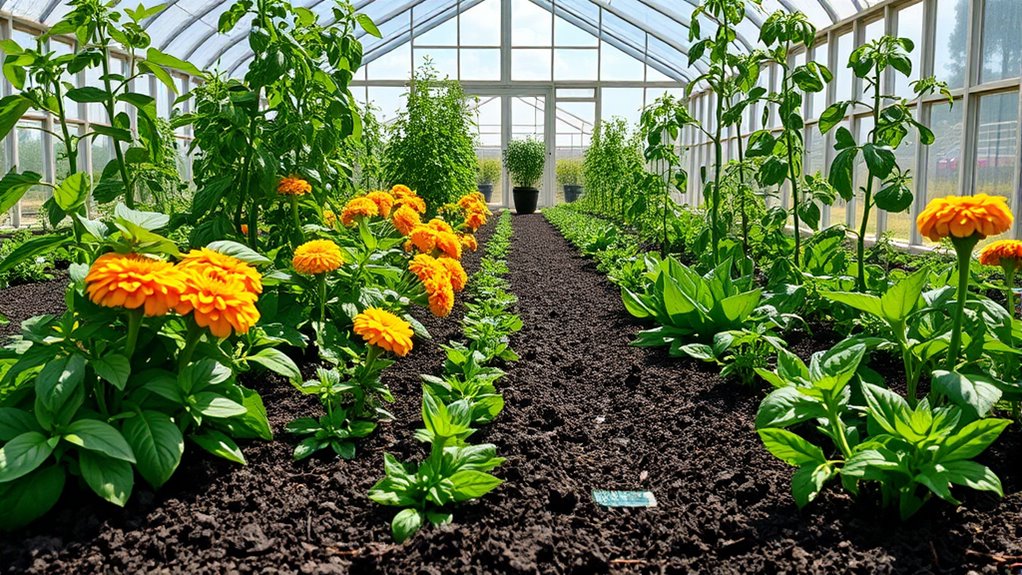
Companion planting can significantly enhance the health of your greenhouse garden by fostering beneficial relationships among plants.
By pairing crops with complementary growth habits, you can optimize your space and ensure that plants with similar nutrient needs thrive together. Be mindful of negative pairings, as some plants can inhibit each other's growth. Effective partnerships lead to thriving greenhouse gardens, making it essential to choose your combinations wisely.
Pairing crops with compatible growth habits maximizes space and supports healthy nutrient sharing while avoiding harmful plant combinations.
Incorporate pest-repellent plants to manage pests naturally, reducing the need for chemicals. Additionally, planting flowers near your crops attracts pollinators, boosting yields.
Effective combinations like basil with tomatoes or marigolds with cucumbers can enhance flavors and protect your plants.
Start small, keep records of pairings, and adapt your strategy to your unique conditions for a thriving, healthier garden.
Seasonal Maintenance for Your Greenhouse
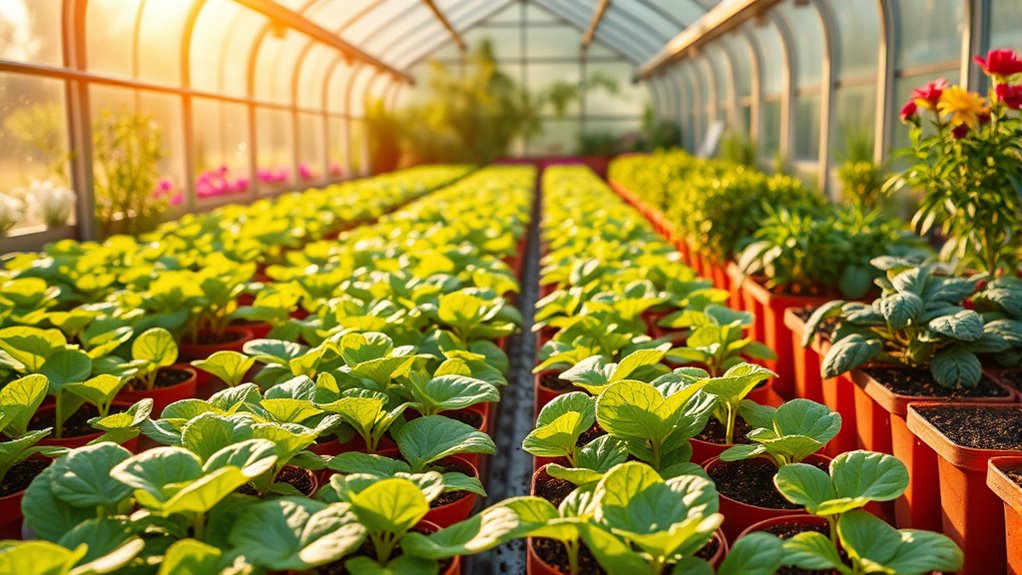
Maintaining a healthy greenhouse goes hand in hand with planting strategies like companion planting. Start by cleaning out old debris, plant material, and weeds. Sweep and wash surfaces thoroughly, using mild detergent for stubborn spots. Additionally, seasonal preventative measures such as insect traps can significantly reduce pest issues.
Don't forget to sanitize all your tools and equipment to prevent disease.
Next, test your heating, cooling, humidity, and irrigation systems. Check that sensors are calibrated and clean nozzles and vents for optimal function.
Inspect the greenhouse structure for cracks, wear, and ensure pots are intact.
To manage pests, set up insect traps and inspect plants regularly for signs of stress. Maintain good air circulation and clean gutters and drainage systems to avoid blockages.
This proactive approach ensures a thriving environment for your spring crops.
Creative Uses for Your Spring Harvest
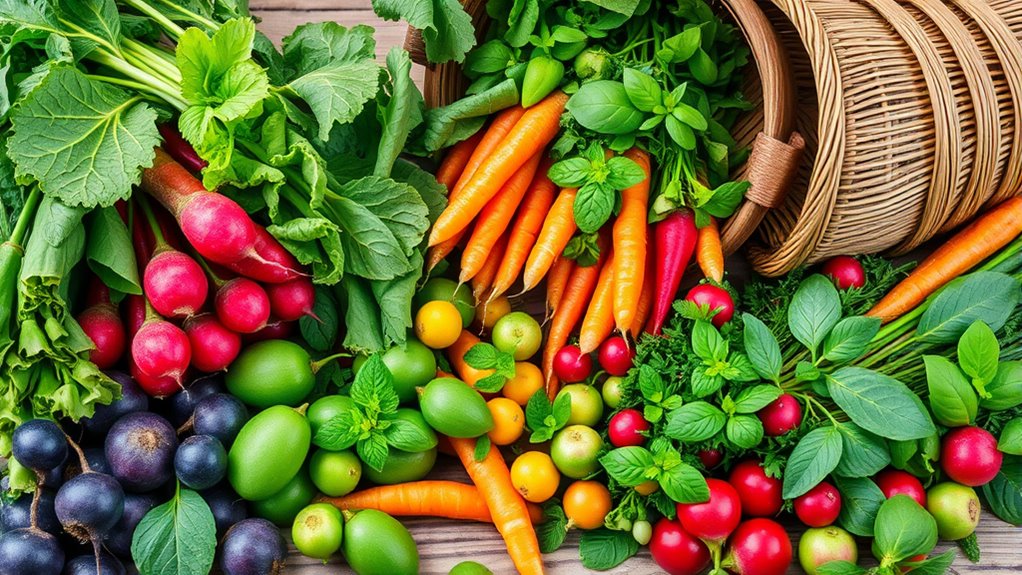
As spring brings a bountiful harvest from your greenhouse, you'll find countless creative ways to make the most of your fresh produce.
Consider crafting vibrant flower arrangements to showcase on your shelves, or create eye-catching succulent displays that highlight their unique shapes. Transform your shelves into a thriving herb garden for easy access to fresh ingredients, or use them to display bonsai trees for a touch of elegance. Incorporating exotic plant varieties into your displays can further enhance the visual interest of your greenhouse. Additionally, showcasing seasonal flavors can inspire your visitors to appreciate the beauty of seasonal produce.
In the kitchen, fresh herbs can elevate your dishes, while microgreens add flavor and nutrition. You can also create infused oils or dry herbs for teas and tinctures.
Don't forget to incorporate artistic elements, like themed displays or hanging gardens, to enhance your greenhouse's ambiance and make it a haven of creativity.
Frequently Asked Questions
What Are the Best Greenhouse Materials for Spring Planting?
When choosing greenhouse materials for spring planting, consider durability and insulation.
You'll want polycarbonate panels for light transmission and longevity, along with galvanized steel frames for strength.
Incorporate double-walled polycarbonate for better insulation and regulate temperature with effective ventilation systems.
For soil, mix in peat moss or coconut coir to retain moisture, and use compost to enrich nutrients.
With the right materials, you'll create an ideal environment for your spring crops.
How Can I Prevent Pests in My Greenhouse During Spring?
To prevent pests in your greenhouse during spring, start by installing fine-mesh insect screens on vents and doors.
Maintain optimal temperature and humidity levels to keep plants healthy.
Regularly clean your space and create a quarantine area for new plants.
Monitor your crops weekly for any signs of pests, using yellow sticky traps for early detection.
Consider introducing beneficial insects and using organic sprays like neem oil for effective control.
What Is the Ideal Watering Schedule for Spring Crops?
To establish an ideal watering schedule for spring crops, you'll want to water 1-2 times per week, depending on the weather.
Morning is the best time for watering, as it allows plants to absorb moisture before the heat sets in.
Check soil moisture regularly, aiming for about 1 inch of water weekly.
Adjust your schedule based on environmental factors, and always water at the base of plants to promote healthy root growth.
How Do I Manage Humidity Levels in My Greenhouse?
Imagine your greenhouse as a delicate orchestra, where humidity plays the melody. To manage this symphony, you'll need to fine-tune the instruments.
Ventilate by letting fresh air flow in, circulate it to maintain harmony, or use a dehumidifier to reduce excess moisture. If your crops crave more humidity, consider misting or adding humidifiers.
Keep an eye on your humidistats; they're the conductors that ensure every note is just right for your plants' growth.
Can I Grow Spring Crops in Containers Inside My Greenhouse?
Yes, you can absolutely grow spring crops in containers inside your greenhouse!
Container gardening lets you maximize your space and control the environment for your plants. Just make sure you choose the right-sized containers, provide adequate drainage, and use quality soil.
You'll find that crops like tomatoes, peppers, and leafy greens thrive in this setup, giving you a bountiful harvest throughout the spring season.
Enjoy the process and watch your garden flourish!
Conclusion
As spring unfurls its vibrant petals, your greenhouse becomes a canvas for nature's masterpiece. By nurturing leafy greens, warm-season veggies, and aromatic herbs, you're painting a picture of abundance. Just like a gardener tending to a budding friendship, you'll watch your efforts blossom into a bountiful harvest. Embrace the nurturing spirit of the season, and let your greenhouse thrive. Remember, each seed you plant is a promise of growth, waiting to flourish under your care.




